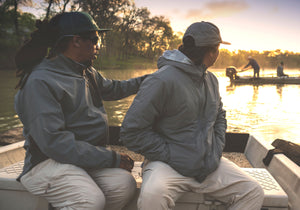Many anglers associate fly fishing with rivers and chalkstreams — but did you know that there’s tons of opportunity to go fly fishing in reservoirs, lakes, and other stillwater areas?

Stillwater fly fishing requires a slightly modified technique. But even if you’ve never fished on the fly before, it’s a great introduction to the sport. In this article, we’ll explore the difference between river and stillwater fly fishing, the equipment you need, and how to spot fish in stillwater reserves.
What’s the difference between stillwater and river fly fishing?
River fly fishing involves casting based on the flow of the water. Take trout fishing. Trout tend to wait for food to be swept downstream with the current, so your fly is often cast upstream and allowed to float towards the waiting fish.
In a reservoir, lake, or other stillwater, the water behaves differently. The name ‘stillwater’ is a slight misnomer — while the water doesn’t actively flow in the same way as a river, there are still currents, wind, and other movements you need to contend with.
The water may also be much deeper, with cooler water temperatures and more plentiful food. Most anglers find they have to play with the depth of their fly for successful reservoir or lake fly fishing, rather than the distance.
Is it hard to fish a reservoir or other stillwater?
Some anglers prefer to fish in stillwater than in rivers or streams. This is especially true if fish are stocked regularly — greater competition makes it more likely that fish will take the fly, boosting your confidence.
What equipment do I need for reservoir fly fishing?
You don’t need any specialist equipment for reservoir fly fishing if you already have all your fly fishing gear. In fact, you need fewer items than for river fishing, as you won’t need waders. On smaller reservoirs, fishing is usually done from the bank.
Boats are popular when fishing in larger lakes and reservoirs. Float tubes are also sometimes used, although you’ll need waders for fishing from a float tube.
If possible, choose a rod and line with an AFTM rating of 5-8 for stillwater fishing. Find out more about choosing a reservoir fly rod.
Lures are often successful when fishing a reservoir. Lures are a strong choice for deeper waters, and can tempt trout lurking near the bottom. If you don’t have any lures in your tackle box yet, this lure collection is a good place to start.
Other anglers have had success using other types of fly, including dry flies, especially in warmer weather when fish rise to feed on midges and other surface insects. As with all types of fly fishing, you must find out where fish are feeding and at what depth to help decide which fly will work best. Our stillwater fly collection contains all the must-have flies for this type of fishing.

Finding the fish in a lake or reservoir
Reservoir fish tend to lurk deeper in the water than river fish, depending on the water temperature and food location. They also move around to find warmer or cooler waters and food-rich locations.
To locate the fish, assess the movement of the water. This won’t be an obvious current like in a river, but even on calm days there will be indications of wind on the water. In stillwater, the undercurrent flows in the opposite direction of the wind to maintain the water level.
In hot weather, expect the fish to be found in cooler parts of the lake (and vice versa). When warm winds have been blowing across the surface, the warmest area tends to be at the leeward end. The water cools as it returns with the current in the deeper parts of the lake. In warm weather, fish will seek cooler waters; in cool weather, fish will look for warmth.
You’ll need to be totally in tune with your surroundings to find the fish. After a few visits, though, you should get a feel for where the fish are likely to be. Then you can take advantage of having a captive pool before you. That’s why fishing in stillwater lakes and reservoirs is popular all year round.
You can also see where fish-feeding birds are flocking, and look for activity in shallower waters.
Where can I find a reservoir for fly fishing?
There are dozens of fisheries, reservoirs, and lakes where you can fish on the fly across the UK. You’ll need a permit and day ticket, which you can often book online, as well as a rod licence (in England and Wales). Rules and advice may differ from one reservoir to the next in terms of where it’s safe to fish and which fish you’re allowed to take. Practise catch-and-release where possible to ensure healthy fish populations and prevent undue harm to the fish.
Learn more about UK trout fly fishing
Looking for more tips and tricks on how to find and fish trout on the fly? See our guide to trout fly fishing to learn more.

